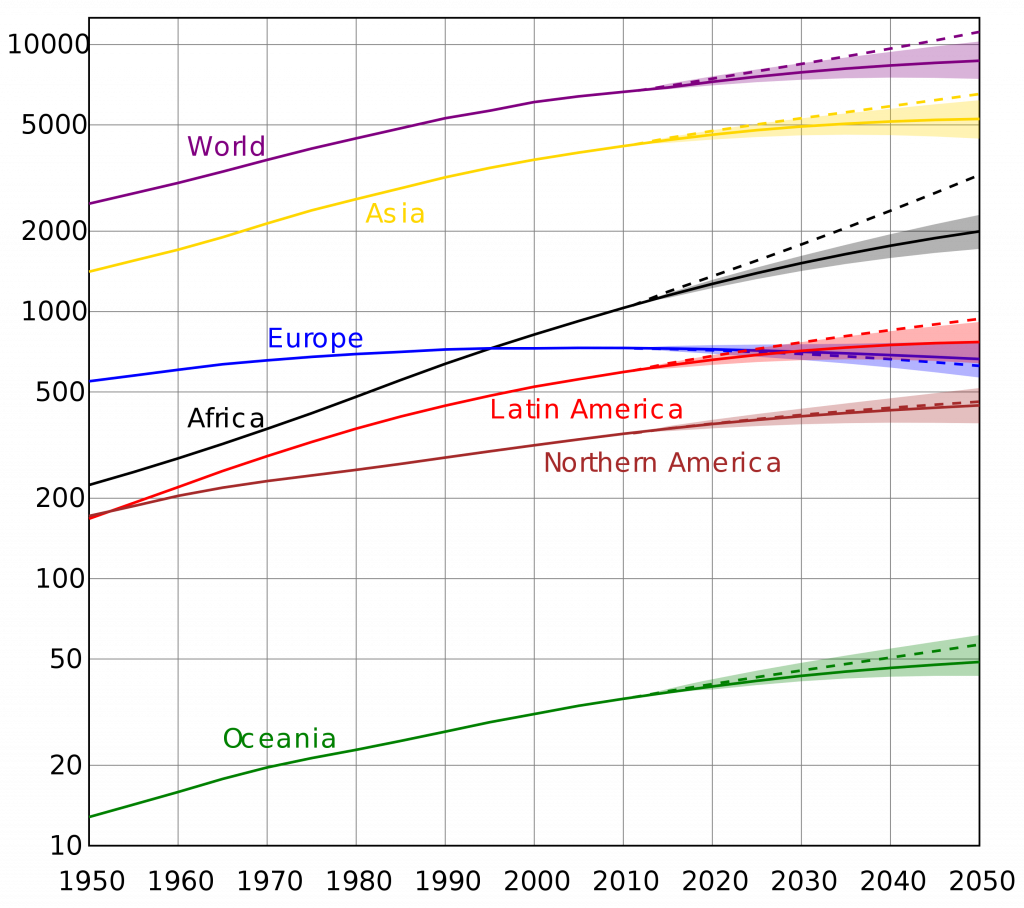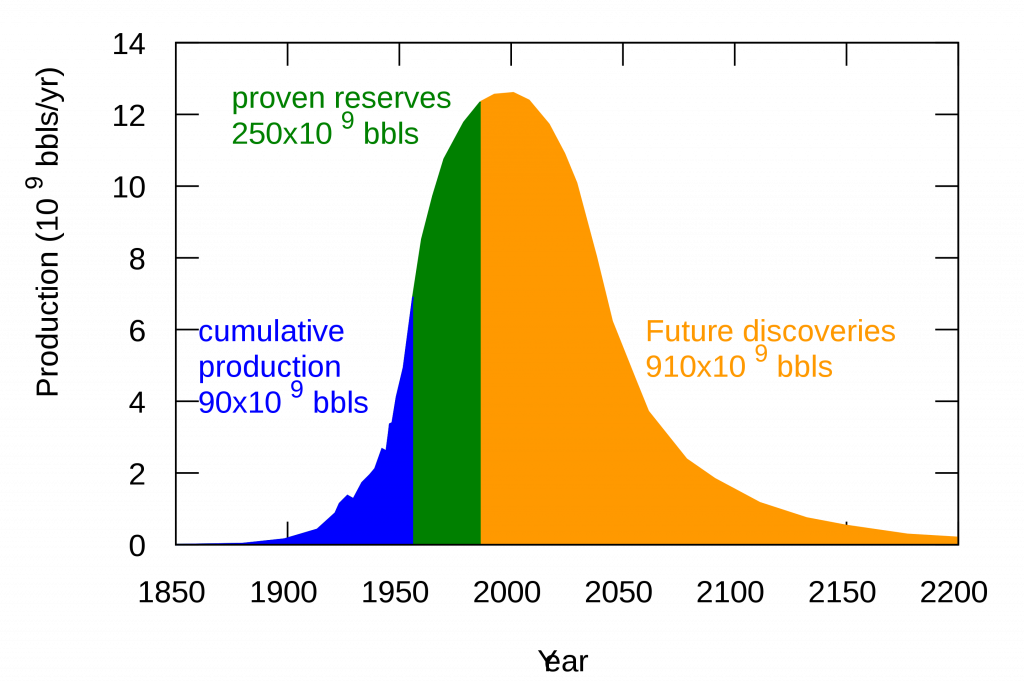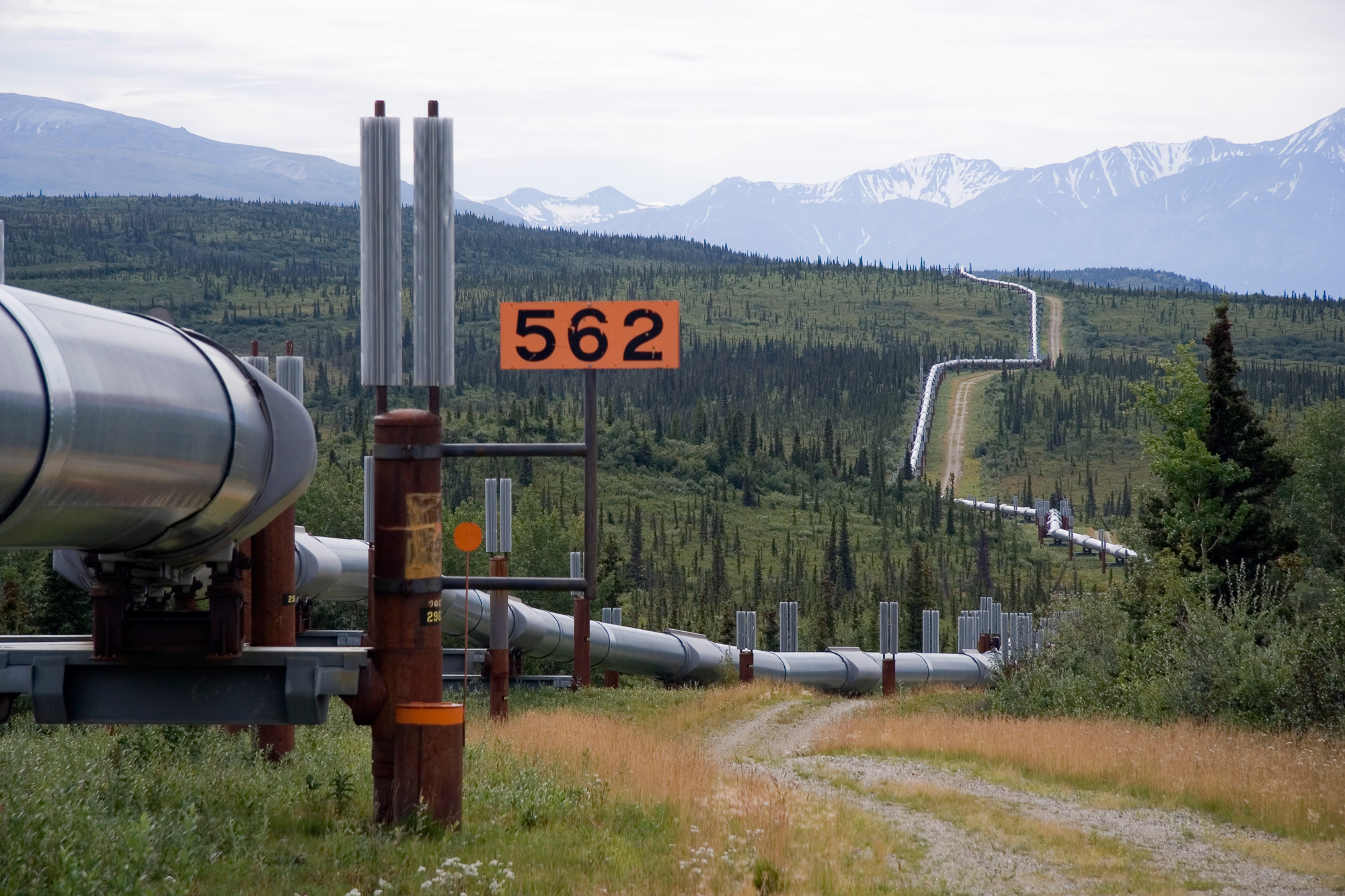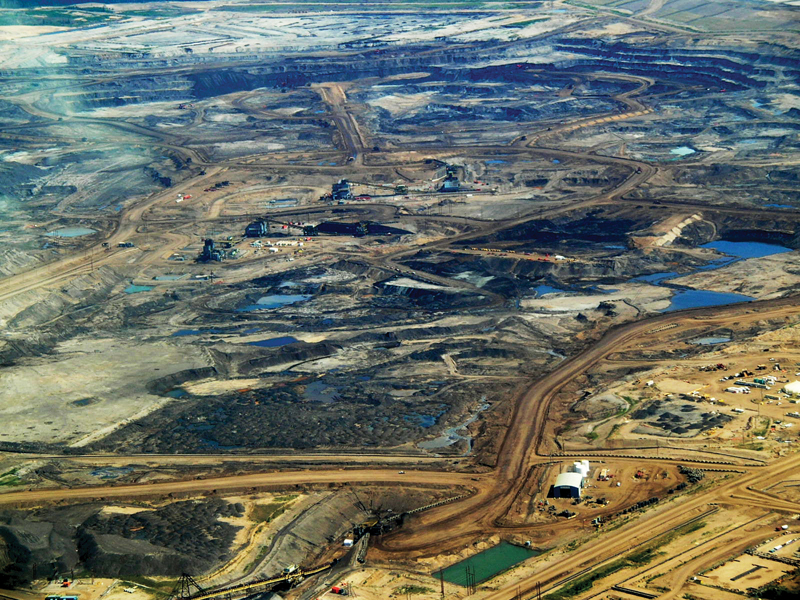13 Limits to Growth?

One of the most basic but often overlooked aspects of human interactions with the environment that we study in Environmental History is the impact of population growth. There are a number of reasons people have tended to avoid thinking about the danger of having too many humans around. We like people. Especially those that are close to us. And historically, the growth of our own particular group has been important for our survival and therefore has been desirable. In the past, people haven’t always been too concerned if the success of their particular community came at the expense of their neighbors. And recently that neighborhood has expanded to cover the whole globe.
There’s an economic concept called the zero sum game that says for every winner there has to be a loser. Since the industrial revolution though, Westerners have been able to live outside of the constrictions of zero sum logic. But that doesn’t mean Westerners have been unaware of the question. At the very beginning of the modern age, an English economist named Thomas R. Malthus (1766-1834) published a short book called An Essay on the Principle of Population. Malthus’s theory, published in 1798, became instantly controversial on both sides of the Atlantic. Thomas Jefferson sent a copy of the book to his favorite economist and asked for an opinion.
Malthus stated his basic idea like this: “The increase in population is necessarily limited by the means of subsistence…the population does invariably increase when the means of subsistence increase, and …the superior power of population is repressed and the actual population is kept equal to the means of subsistence only by misery and vice.” Another way of saying that is, population grows as long as there is food and water to support it, and when these resources run out, population is brought back down through famine, disease, and war. These three causes of depopulation are often termed “Malthusian disasters.”

Malthus went on to observe that populations tend to increase geometrically: two people become four, four become eight, eight become sixteen, etc. In contrast, he said, food supplies at best increase only arithmetically: two bushels of wheat become four, which become six, which become eight. By this logic it is easy to see that a society can easily outrun its ability to feed itself if the population is not kept down by reducing births or increasing deaths, and to understand why early modern Europeans were so obsessed with acquiring new territories to improve their food production abilities. The famines, diseases, and wars of European history gave Malthus the examples he needed of the crises that tended to reduce populations. If society was going to avoid these periodic disasters, he argued, then it would need to find some way of limiting the birthrate to avoid starving. The Malthusian theory, as it is called, was intensely controversial right from the start. One of the reasons was that it advocated birth control. Malthus himself only called for what he termed “moral restraint” to help reduce the birth rate, but many Malthusians had more active contraceptive measures in mind. The idea of limiting reproduction was seen by most religious people as a violation of the injunction to “be fruitful and multiply,” and eliminating the risk of pregnancy was seen as an encouragement of vice and an invitation to sin. Over two centuries later, we have not left these arguments behind.

The other big controversy surrounding Malthusian thought was that it was used by some members of the British upper classes to argue that the conditions of the poor should not be improved. If poor people had higher wages and more to eat, they argued, they would have more children and more of their children would survive, which would put unnecessary stress on the social system and in the long run lead to mass starvation. The poor simply had to suffer, they said, or society was doomed. But the assumption held by Malthus and those members of the British upper class (and by many people today) that feeding the poor would lead to a population explosion turns out, actually, to be untrue. Population scientists today agree, after studying societies all over the world, that as economic security increases, a “demographic shift” occurs and birth rates decline. In other words, if the poor have enough to eat, infant mortality rates and the fear of starving in old age decrease. Death rates decline and as a result parents have fewer children. Educating women is the other major factor demographers have identified with reducing birthrates. Both factors have contributed to a demographic shift in the developed world where family sizes have decreased from an average of six children per family to 1.6 in the modern era.
A short, emphatic video by demographer Hans Rosling. CC BY license, Gapminder.org. https://youtu.be/BkSO9pOVpRM
In spite of the developed world’s success limiting population growth by providing education for women and a social safety net, the argument is still raging regarding the “developing world.” The Gates Foundation recently started a campaign called #StopTheMyth. According to their short video titled “You Decide: Save the People or Save the Planet,” the issue is still very poorly understood. Melinda Gates points out that in Afghanistan, where 10% of children die before the age of five, population is expected to nearly double by 2050. In Thailand, on the other hand, the number of children dying has decreased substantially. And so has the birthrate. “Clearly,” Gates says, “letting children die now so they don’t strain the planet later doesn’t really work. It’s a myth.”
The other assumption you may have noticed in the Malthusian theory was that food production can only increase slowly. As we have already seen, this has not been the experience of the nineteenth and twentieth centuries. Abundant land, fertilizers, and technology created a global Green Revolution that has allowed us to continually outrun Malthus for the last two centuries. But an agricultural scientist named Karl Sprengel noticed in 1828 that plant growth was limited by the availability of the essential nutrient with the lowest concentration. Sprengel’s contemporary, biologist Justus von Liebig, realized Sprengel’s idea had wider applications and popularized it as Liebig’s Law. The Law, which became a key idea in ecology, states that growth is dictated not by the total resources available, but by the scarcest resource, which he called the limiting factor. So the question is, will we be able to keep outrunning Malthus forever, or will a limiting factor end our exponential growth?

Until very recently in human history, the Earth has been so big and the total human population so small relatively, that the resources available to us have often seemed infinite. In 1800 there were fewer than a billion people on the planet. In 1900 there were still less than two billion. By 1960 there were three billion, and in 1999 there were six billion. Current world population is estimated to be about 7.6 billion people. During this dramatic increase, there were periods like the early industrial revolution when worriers like Malthus and his followers expressed doubts and anxiety. Malthus had no idea that his nation was about to expand its empire into Africa and Asia, or that continuing emigration to the Americas and Australia would continue to reduce populations at home. And of course he couldn’t anticipate advances in technology or the demographic effects of increasing economic security we have just discussed. But sometimes even these advances proved temporary or subject to disruption. The population of Ireland boomed in the first decades of the nineteenth century, as potatoes increased the calories available to poor people and seemed to eliminate the threat of famine. The Irish population peaked at over 8 million in 1841, but the blight that eliminated their main food source killed over a million people and forced a million more to emigrate to America. The Irish population is about 4.8 million today, a little more than half its peak 175 years ago. And finally, as the science of ecology developed in the second half of the twentieth century and we began to distinguish between renewable and nonrenewable resources, Malthusian anxiety has returned.

In 1968 Stanford University Biology professor Paul R. Ehrlich published a sensational book called The Population Bomb, that was an instant bestseller. It began with the statement, “The battle to feed all of humanity is over. In the 1970s, hundreds of millions of people will starve to death in spite of any crash programs embarked upon now. At this late date, nothing can prevent a substantial increase in the world death rate.” Ehrlich became a celebrity and publicized his theories of social collapse on popular media like Johnny Carson’s Tonight Show. Ehrlich’s scenarios inspired some great dystopian science fiction, but luckily they did not happen in the way Ehrlich had predicted. Actually, a couple hundred million people did die of hunger in the decades after the book’s publication (it’s hard to tell exactly because when the United Nations reported worldwide deaths, it specifically omitted deaths from hunger). But these deaths did not reduce world population overall or result in the social chaos that Ehrlich had prophesied.
The Population Bomb may have done more harm than good in the long run, by making the population issue an easy target for critics. But people remained concerned about the rapid increase of the world’s human population. In 1972 an international organization called The Club of Rome published a study titled The Limits to Growth. Unlike Ehrlich’s sensational predictions of doom, Limits applied mathematical systems modeling to five particular variables: world population, industrialization, pollution, food production, and natural resource depletion. The researchers used newly-available computer technology to produce a study that illustrated the interaction of these variables by showing three potential future outcomes. In two of these scenarios, the global system experiences what the researchers called “overshoot and collapse” in either the mid or the late twenty-first century. In the third scenario the computer models arrived at what the researchers called a stabilized world system.
In 2008, the original authors of The Limits to Growth returned to their models and published a 30-year review of how accurate their predictions had been. They found that measurements of all the variables they had identified were tracking with the predictions the computer models had made for an “overshoot and collapse” scenario. The accuracy of the predictions the study had made for the short term does not prove their longer-term predictions were accurate, of course. However, the findings do suggest that further study might be in order.

Peak Oil and Climate Change
But not all the warnings that humanity is reaching resource limits have come from university academics or international think-tanks that are naturally distrusted by regular people and corporate leaders. Marion King Hubbert was an American geophysicist working for Shell Oil in 1956 when he presented a research paper to the oil industry trade group The American Petroleum Institute, where he showed that for any geographical area (and by implication, for the planet as a whole), petroleum production follows a predictable bell-shaped curve. Hubbert’s theory correctly predicted that oil production in the continental US would peak between 1965 and 1970, and then begin to decline. Hubbert also predicted that world oil production would peak “in about fifty years.” Although the data and especially its interpretation are very controversial, several credible sources suggest that the peak in world production happened between 2003 and 2004, right on schedule.
Petrochemical prices can be expected to rise as supplies diminish. Currently, new technologies such as fracking and converting tar sands have added some new sources to the supply we now designate as “petroleum.” These new additions do not refute the logic of Hubbert’s predictions, although they do potentially push back the anticipated supply crunch expected to raise prices. Two elements of The Limits to Growth’s computer mode, industrial production and food, depend heavily on the price of energy, and a third (pollution) is an issue for both fracking and tar sands processing. A reduction of the supply of oil, an increase in its cost, or an increase in pollution could all have a significant negative impact on those variables.

Hubbert’s words actually echoed Malthus. “Our principal constraints,” he said, “are cultural. During the last two centuries we have known nothing but exponential growth, and in parallel we have evolved what amounts to an exponential growth culture. A culture so dependent on the continuation of exponential growth for its stability that it is incapable of reckoning with problems of non-growth.” These are not the words of some dewy-eyed environmentalist or crazy academic or sensationalist. Hubbert was an oil industry analyst. Some have argued that possible future discoveries of more oil could postpone society’s shift to a non-fossil fuel energy economy. But even the oil industry for the most part agrees that production will decline. So the question we are left with is, how quickly will we use up what remains?
Some climate activists have begun to suggest that for the sake of the environment, we ought to switch from fossil fuels to other energy sources as soon as possible and leave a lot of what is left in the ground. The argument against burning the rest of the oil (and coal) is that fossil fuels are one of the biggest contributors of atmospheric carbon that leads to global warming. While this is true, other factors such as deforestation and even agribusiness release comparable amounts of carbon. Simply stopping the use of oil will not solve the whole climate change problem, although it is an important element of the change society needs to make to stabilize the global climate.

But because energy is such a large part of the economies of developed nations, any change is heavily contested. Global energy corporations have a nearly incredible ability to influence politics. A few years ago BP (British Petroleum, established in 1908 as the Anglo-Persian Oil Company and now operating in 72 countries) issued an “Energy Outlook” report for the year 2035, which claims that Hubbert’s Peak Oil scenario is actually incorrect and announces the company’s intention to burn just as much as possible over the next two decades. BP’s claim that oil production hasn’t peaked, however, depends on a redefinition of the word oil that includes both tar sands and biofuels such as ethanol. Ethanol production, as discussed previously, depends not only on the energy-intensive production of surplus corn and cane sugar (used in Brazil as the primary plant source), but in government subsidies that keep the price of these commodities below their cost of production. So it’s hard to see how biofuels could legitimately be called a new source of “oil.”

Climate change, more than any other environmental concern, has dominated the attention of Americans in recent years (and has in many cases pushed pollution off the table, which is unfortunate). Although the idea that the planet’s climate has been adversely affected by human activity is very controversial in the media, politics, and popular culture, it is almost universally accepted by scientists. According to NASA, at least 97% of climate scientists agree that global warming over the past couple of centuries is due to human activities, or anthropogenic. American and international science organizations like the American Geophysical Union, the American Meteorological Society, and the American Medical Association, in addition to the Intergovernmental Panel on Climate Change, have all gone a step further, saying in the words of the American Physical Society, “We must reduce emissions of greenhouse gases beginning now.”

Of course who they mean by “we” is unclear, and the penalties for heeding their warnings are really hard to specify. The science is complicated and it is difficult for some people to understand. And to make matters worse, most Americans share a belief system that distrusts science and scientists, because science seems to contradict their most cherished religious doctrines about the nature of the world and their place in it. To make matters even worse, concern over climate change has been identified with a particular political orientation. The claim that only liberals care about the environment is not only absurd, but it ignores the traditional meaning of the word conservative. In reality, this is not a liberal vs. conservative issue. The argument against climate change has been carefully managed and funded by political action committees and foundations representing corporations that oppose changes in energy policy.
Although 97% of climate scientists agree on anthropogenic climate change, when Americans are asked, “Do most scientists believe that the Earth is getting warmer because of human activity?” 55% say either “No” or that they don’t know. Less than half of Americans are aware that scientists are basically unanimous on this issue, and thinking that scientists are unsure affects their own opinions about climate change and the the government policies they are willing to support to mitigate it. A recent study found that most of the public statements against climate change made from 2003 to 2010 could be traced to about 91 organizations which received $558,000,000 in grants during that period. From 2003 to 2007 this money was easily traceable to sources such as Exxon-Mobil and Koch Industries, two corporations opposed to changes in energy policy. With the changes in foundation funding that followed in the wake of the 2008 Citizens United Supreme Court decision that allowed corporations to hide their political spending, the sources of money funding climate change denial have been more difficult to trace. Ultra-free market foundations and even a few religious organizations like the John Templeton Foundation fund websites like Climatedepot.com that go out of their way to label any scientist endorsing climate change a “Warmist” who is probably working for Al Gore in an effort to regulate every aspect of our lives in some big global prison state. Climate deniers warn of the “command economies” they claim environmentalists wish to impose, using language designed to rile up libertarians and free market enthusiasts and mobilize them against changing the economy in ways that although bad for oil companies, would almost certainly create millions of new jobs.
A 4-minute University of Queensland video on Climate Change Denial, showing that the issue isn’t unique to America. CC BY license, https://youtu.be/5bmyOaWKksA.
This is unfortunate, to say the least. While Germany is becoming a world leader in solar energy deployment, in spite of receiving only as much sunlight as Alaska, and while Britain is mapping its shift to a post-oil based economy with its “transition towns,” many Americans continue wasting their time arguing over the make-believe issue of climate change denial. Of nearly 14,000 peer-reviewed climate articles published between 1991 and 2012, only 24 reject global warming. There really isn’t any doubt that the Earth’s climate is changing in ways that are going to cause serious social disruption in the future. When political leaders say there is still doubt about the need to address climate change, we should follow the money to discover why. Our unwillingness or inability to understand the situation causes us to continue being manipulated by organizations interested in maintaining the status quo, and may mean that our choices in the future will be much more limited than they need to be.
Further Reading:
David Holmgren, Future Scenarios: How Communities Can Adapt to Peak Oil and Climate Change. 2009.
Marion King Hubbert, “Nuclear Energy and the Fossil Fuels”, Publication No. 95, Shell Development Company, 1956. http://www.hubbertpeak.com/hubbert/1956/1956.pdf
Bill McKibben, Eaarth: Making a Life on a Tough New Planet. 2010.
Donella H. Meadows, Limits to Growth: The 30-Year Update. 2012.
Naomi Oreskes and Erik M. Conway, Merchants of Doubt: How a Handful of Scientists Obscured the Truth on Issues from Tobacco Smoke to Global Warming. 2010.
Media Attributions
- Thomas_Robert_Malthus_Wellcome_L0069037_-crop © John Linnell is licensed under a Public Domain license
- 1600px-Malthus_PL_en.svg © Kravietz is licensed under a CC BY-SA (Attribution ShareAlike) license
- L0000878 Wentworth st, Whitechapel © Gustave Dore is licensed under a CC BY (Attribution) license
- 1280px-Population_curve.svg © El T is licensed under a CC0 (Creative Commons Zero) license
- 2880px-World_population_(UN).svg © Conscious is licensed under a CC BY-SA (Attribution ShareAlike) license
- _Hunger._For_three_years_America_has_fought_starvation_in_Belgium._Will_you_Eat_Less-wheat,_meat-_fats_and_sugar_that…_-_NARA_-_512582 © Unknown is licensed under a Public Domain license
- 2880px-Hubbert_peak_oil_plot.svg © Hankwang is licensed under a CC BY (Attribution) license
- Trans-Alaska_Pipeline_System_Luca_Galuzzi_2005 © Luca Galuzzi is licensed under a CC BY-SA (Attribution ShareAlike) license
- Tar_sands_in_alberta_2008 © Howl Arts Collective is licensed under a CC BY (Attribution) license
- 1309_temp-data-from-science-institutions © NASA is licensed under a Public Domain license

